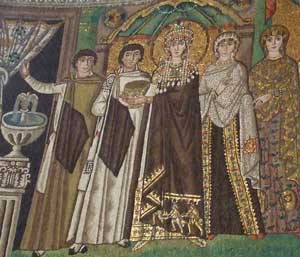About Ravenna
Ravenna is an elegant town in the Emilia-Romagna region of Italy; not far from the Adriatic coast. It is most famous for its fabulous early Christian and Byzantine mosaics, which date back to the time when Ravenna was the capital of the Western Empire, then under Ostrogoth and Byzantine rule. The town’s greatest mosaics have been given UNESCO World Heritage status.
Nowadays the town is a pleasant place to wander and to spend a night or two. It is not one of Italy’s most obvious tourist destinations, and appeals mostly to those who have specialised interests or want to know the country in greater depth. This means that the streets are not over-crowded with tourists or souvenir stalls, and there is a real ‘local’ feel as residents bump around the town’s lanes on their bicycles, greeting friends and collecting the shopping. However, the main attractions do seem to be on quite a few tour groups’ itineraries. When I was there, the groups – mostly Italians and schoolparties – seemed to arrive and leave by coach so they didn’t flood the town. But it meant that within the main churches and in their immediate vicinity there were sometimes uncomfortable crowds. The best thing to do is to try to avoid them, perhaps picking times to visit first thing in the morning, in the later afternoon, or while they are all at lunch. I found that the groups were only visiting one or two of the biggest sites, so the smaller attractions were much quieter and sometimes I was the only visitor.
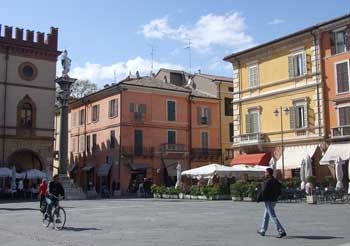
Ravenna tourist attractions
The heart of Ravenna, and the best place to get your bearings, is Piazza del Popolo, which can be reached in ten minutes from the railway station by walking straight ahead along Viale Farini and then Via Diaz. This charming piazza is lined with attractive historic buildings including the Palazzo Comunale (Town Hall), originally built in the fifteenth century. As they did elsewhere, the Venetians erected two columns in the square during their rule; instead of Venetian emblems these are topped with statues of Ravenna’s patron saints San Vitale (St. Vitalis) and Sant’Apollinare (St. Apollonaris). There are cafes with outdoor tables, and it’s a lovely place to sit and relax.
The most important tourist attractions in Ravenna are the mosaics, and the churches housing them, which are on UNESCO’s World Heritage listing. These first five can be visited on a combined ticket:
Basilica di San Vitale – this church is the glory of Ravenna. Built between 526 and 547 the building has a simple brick exterior but the interior is rich with marbles and mosaics. Byzantine mosaics illustrate scenes from the Old Testament and also lovely representations of the Emperor Justinian, the Empress Theodora and their elegant retinues. Note that the building is closed to tourists during Mass on a Sunday morning.
Mausoleo di Galla Placidia (Mausoleum of Galla Placidia) – alongside San Vitale and visited at the same time, the mausoleum is a surprisingly tiny building: try to get inside when there is no tour group. Galla Placidia was an important woman: born in around 390 AD, she was the daughter, sister, wife and mother of Roman emperors and had a full and colourful life. This building is said to have been built as her tomb; however she died in Rome and her body may never have been brought here. The ceiling is a blue field of little gold stars, with a cross in the centre and symbols of the Evangelists at each corner. Pictorial mosaics on the walls include a lovely one of the Good Shepherd.
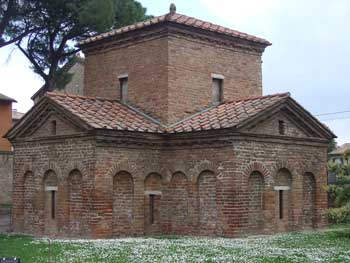
Battistero Neoniano – this baptistery was built at the beginning of the fifth century and was renovated by a bishop called Neone fifty years later (hence the name). The building is octagonal and its interior is highly decorated with marbles, carvings and mosaics. The mosaic in the domed ceiling portrays the story of the baptism of Christ by John the Baptist.
Basilica di Sant’Apollinare Nuovo – this basilica houses some of the most reproduced of Ravenna’s mosaics. A mosaic frieze shows processions of martyrs and virgins leaving Ravenna – represented by the palace of Theodoric – and the port of Classe to pay tribute to Christ and the Madonna.
Cappella Arcivescovile, also called the Cappella di Sant’Andrea – closed for restoration at the time of writing, this chapel contains sixth-century mosaics.
Mausoleo di Teodorico (Mausoleum of Theodoric) is also listed by UNESCO; it can be visited on a combined ticket with the Museo Nazionale and the Basilica di Sant’Apollinare in Classe, which is outside Ravenna and which is described below. The mausoleum, a striking white cylindrical building, was built outside the city walls so is some way from the other tourist sights of Ravenna. Theodoric, known as ‘the Great’, was the King of the Ostrogoths and became ruler of Italy, with his capital here in Ravenna. His tomb, constructed around 520, is topped with a single, massive block of stone. Visitors can enter the building and climb to the upper floor.
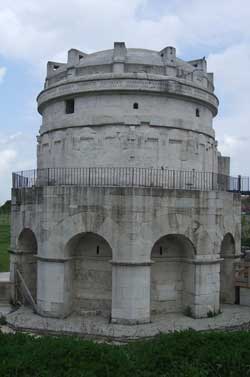
Battistero degli Ariani (Arian Baptistery). This small sixth-century baptistery is crowned by another lovely mosaic illustrating the baptism of Christ, this time with the inclusion of a personification of the River Jordan. The Apostles are portrayed circling the scene. The building is free to enter.
Ravenna’s museums are not terribly well-laid out; when I visited I found they lacked marked routes and it was hard to locate important exhibits or work out whether I had seen all the rooms. They do contain some interesting exhibits though, and if you have the time it is worth visiting at least these two:
Museo Nazionale (National Museum) – this is part of the same complex as San Vitale and the Mausoleum of Galla Placidia, although it is entered on a different combined ticket as described above. The contents of the museum range from the interior of a historic pharmacy to a section on the prehistoric era. There is some attractive inlaid furniture including a fantastic sixteenth-century cherry-wood cabinet decorated with imaginary towns, hunting scenes and fair ladies. One of the most interesting exhibits is a small section of mosaic from San Vitale, showing the head of an angel. Being able to examine this at close quarters provides a real insight into the techniques and skills employed to create the mosaics of Ravenna.
MAR – Ravenna’s art gallery hosts temporary exhibitions as well as containing a large permanent collection. One of the museum’s highlights is the marble effigy of a knight, Guidarello Guidarelli, sculpted by Tullio Lombardo.
This list of tourist sights may seem long, but Ravenna does have still more museums, churches and parks to visit. The old town fortress, the Rocca Brancaleone, now has a little park inside its walls, with a cafe and children’s play area. In a conveniently central location is the much-rebuilt church of San Francesco, which has a charming crypt visible through an internal window: it is is flooded, with goldfish swimming over a mosaic below. Alongside is the Tomba di Dante, the tomb of Italy’s great writer Dante Alighieri who died in Ravenna in 1321. In this little eighteenth-century chapel is a bas-relief of Dante by Pietro Lombardo and a light kept burning with oil donated by his birthplace, the city of Florence. Remains of the Roman town can be seen in the Domus dei Tappeti di Pietra (House of the Stone Carpets); where in recent years some Roman mosaic floors have been uncovered. Other museums in and around Ravenna include museums devoted to the Risorgimento, Dante, dolls and nature.
There is a chapter on Ravenna (The Ravenna Mosaics) in Judith Herrin’s book Byzantium: The Surprising Life of a Medieval Empire, which is a readable overview of the long-lived eastern empire, and a good way to learn more about the context of the town’s Byzantine art.
Sant’Apollinare in Classe
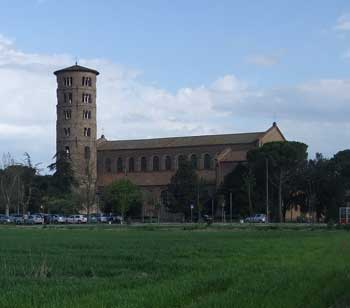
Sant’Apollinare in Classe is a basilica at Classe, some way out of town; if you are using public transport you should allow at least an hour for the return trip. Buses number 4 and 44 pass the basilica, running every half-hour. In Ravenna the buses stop in Piazza dei Caduti and opposite the railway station. Bus tickets cost 1 each way; you should purchase them in advance (the bar alongside the bus stop in Piazza dei Caduti sells tickets). Services are every half-hour, and the journey takes around 15 minutes. You can see the basilica across flat green fields on the left as the bus approaches; the stop is just afterwards. The two bus routes vary slightly after the basilica. For the return trip, you can catch both services at a bus stop on the main road in the direction of Ravenna.
The basilica dates to the early sixth century, and its round campanile (belltower) to the tenth century. The mosaics inside are important and included in the UNESCO listing for Ravenna. They show the transfiguration of Christ, St. Apollonaris with a flock of sheep and a charming landscape of flowers, trees and birds. I was particularly keen to see the scene pictured in old guide books of the basilica standing picturesquely among green and trees. Sadly the effect is marred by busy road systems, recent housing and fences. It is worth seeing the basilica, but if your time in Ravenna is limited, I would concentrate on the central sights. If you are driving towards the coast or seaside resorts towards Rimini, Classe makes an easy stop on your intinerary. Classe (Classis) was the main port of Ravenna, and there is an archaeological area where some of the Roman port has been uncovered between Classe and Ravenna.
Practicalities, food and drink
I stayed for two nights in Ravenna. Although most of the sights have obligingly long and standardised opening hours, it is still quite a trek fitting them all in. If you want to see all the important buildings and mosaics, I would recommend spending at least a day and a night in Ravenna and doing some planning. I actually ended up writing a list and ticking off sights as I visited them. Two days would allow for a more leisurely experience, with pauses over a glass of wine or coffee to reflect on the mosaics you’ve just seen, rather than have them all blurring into one another in your memory. The tourist information office stocks maps and useful information including lists of the sights with their opening times, as well as offering free bike hire, so it’s a good place to start.
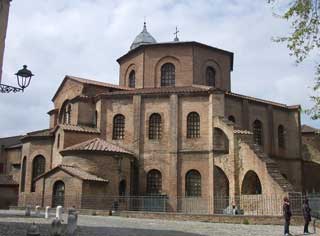
There aren’t actually that many obvious places to eat around the centre of Ravenna, so it’s worth noting any promising restaurants you spot during the day, or asking your hotel for recommendations. I dined twice at Ristorante La Gardela in the heart of town, at Via Ponte Marino 3. This was a simple, bustling restaurant with courteous staff, prompt service and seating outdoors, indoors and up on a mezzanine level. There was a large choice of courses as well as dishes of the day. I spent 19 for pasta (maccheroncini with gorgonzola and walnuts), a grilled vegetable secondo, wine and water. It’s a popular place with tourists, foreign travellers and Italians. When I left at 9pm there were queues to get in. The location is very handy for both the hotels I stayed in (more below).
For a lighter and cheaper meal at lunchtime, you could buy a salad or panino in a bar such as those on Piazza del Popolo, or head up Via IV Novembre where there are a few takeaway places selling pizza slices, rolls and local piadine (flat heated bread sandwiches). There is also an excellent ice cream shop on this street, the Sorbetteria degli Esarchi (Via IV Novembre 11). One of the smarter central places to eat, still on Via IV Novembre, is the restaurant attached to the special little hotel I stayed in: the Albergo Cappello. This also has a bar which attracts elegant Ravennati.
Ravenna used to be a lagoon city which contained canals and waterways, now filled in. Long ago malaria was rife, and in the Middle Ages the writer Dante died after a marshy journey from Venice. In more recent years there have been brief outbreaks of mosquito-carried illness; it’s worth packing your insect repellent in summer and autumn.
Events and things to do
The tourist information office publishes and distributes a magazine with information about Ravenna, and includes special events. Occasional concerts are also advertised on posters around town. The summer is the best time to visit for outdoor entertainments and special concerts: the town hosts the Ravenna Festival with musical, theatrical and dance events, and also there are also special tours organised to see the mosaics by night.
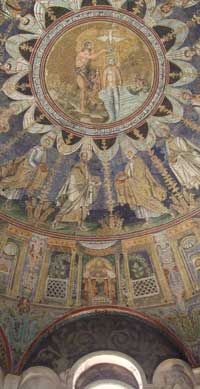
If you are on holiday with children, you may be interested in Mirabilandia, a few miles from Ravenna. This is a theme park which boasts over 30 attractions and rides, and claims to have the highest ferris wheel in mainland Europe. There is a bus service from Ravenna.
For the active, there are cycle tracks leading to the Mausoleum of Theodoric and to Sant’Apollinare in Classe, as well as to the seaside and the Pineta di Classe, the area’s historic pine wood.
Ravenna travel
The nearest airport to Ravenna is at Forlì. Ryanair operate flights to the airport, which they call Bologna Forlì, from the UK and Ireland. In the summer there may be direct bus links to Ravenna from the airport; otherwise take the shuttle bus to Forlì station and change there to another bus operated by the same company, ATR, which will take you to Ravenna (see our links panel for their website with timetables). Alternatively you could take the train but it is likely to take longer as you will need to change at Faenza or Castel Bolognese. Other nearby airports include Bologna and Rimini.
Ravenna is on a rather slow railway line from Bologna (an hour and twenty minutes away by regional train), which has good connections with the Italian rail network. Trains coming from the direction of Bologna continue south to Rimini and other coastal resorts. As your train approaches Ravenna from the Bologna direction you can see the Mausoleum of Theodoric on the left: a white cylindrical tomb. If you are arriving in Ravenna by train, you can walk into the historic centre on foot in about ten minutes. Simply cross the road outside the railway station and head straight ahead along Viale Farini and then Via Diaz until you reach Piazza del Popolo. The tourist information office is a few minutes further away, to the right; it is well-signposted.
Buses in Ravenna are run by ATM (see our links panel for timetables). An urban bus ticket costs 1 at the time of writing, and is valid for an hour. Buy tickets in advance at news-kiosks or bars, and validate them in the machine by the driver when you board.
Local people travel around by bicycle, bumping through the cobbled pedestrianised streets and using cycle lanes heading further afield. The tourist information office has some bicycles which can be borrowed free of charge. There is also a bike hire office just outside the railway station on the left – this kiosk also acts as a left luggage office.
Around Ravenna
Bologna is a big city with lots to see, and it is in easy reach of Ravenna, though the trains are slow. There are also services to the Renaissance city of Ferrara which combines very well with Ravenna as part of a cultural holiday or tour. There are also several smaller towns in the vicinity which could allow for a quieter day trip with one or two sights of interest and time for a long lunch, such as Forlì and Faenza. The Adriatic coast of Emilia-Romagna is lined with seaside resorts: the most famous is Rimini but there are plenty more including Ravenna’s own seaside at Marina di Ravenna. If you are cycling or have a car you can explore more of the local area including the Pineta di Classe. Car drivers can also head northwards to the nature reserves around the Po delta.
Cruises and the port
There is still a large industrial port with a wide canal coming right into Ravenna (just the far side of the railway). It seemed quiet when I walked past its fences, but it was a Sunday. There is a cruise passenger terminal further out of town which can be reached by taxi or ATM bus 72. Ravenna is increasingly featured on cruises around Italy and the Adriatic.
>Cruises around Italy
Accommodation
I’ve stayed, some years ago in two hotels in the heart of town, both on central Via IV Novembre, and I would recommend both of them (but do check the latest guest reviews):
> Hotel Centrale Byron – a very good-value three-star hotel with comfortable rooms; efficient and friendly
> Albergo Cappello – a historic palazzo with seven elegant rooms and suites, and frescoes on the walls; a pricier but more special experience
> More Ravenna hotels and B&Bs
Emilia-Romagna destinations
- Emilia-Romagna region – an introduction
- Bologna
- Castello di Torrechiara
- Ferrara
- Parma
- Ravenna
- Rimini
On this site
Useful external links
Otium exhibition (in Italian)
Mirabilandia fun park (in Italian)
Galla Placidia (in Italian)
Archaeological area of Classe (in Italian)
